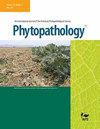求助PDF
{"title":"Assessing the Capacity of High-Resolution Commercial Satellite Imagery for Grapevine Downy Mildew Detection and Surveillance in New York State.","authors":"Kathleen Kanaley, David B Combs, Angela Paul, Yu Jiang, Terry Bates, Kaitlin M Gold","doi":"10.1094/PHYTO-11-23-0432-R","DOIUrl":null,"url":null,"abstract":"<p><p>Grapevine downy mildew (GDM), caused by the oomycete <i>Plasmopara viticola</i>, can cause 100% yield loss and vine death under conducive conditions. High-resolution multispectral satellite platforms offer the opportunity to track rapidly spreading diseases such as GDM over large, heterogeneous fields. Here, we investigated the capacity of PlanetScope (3 m) and SkySat (50 cm) imagery for season-long GDM detection and surveillance. A team of trained scouts rated GDM severity and incidence at a research vineyard in Geneva, New York, from June to August 2020, 2021, and 2022. Satellite imagery acquired within 72 h of scouting was processed to extract single-band reflectance and vegetation indices (VIs). Random forest models trained on spectral bands and VIs from both image datasets could classify areas of high and low GDM incidence and severity with maximum accuracies of 0.85 (SkySat) and 0.92 (PlanetScope). However, we did not observe significant differences between VIs of high and low damage classes until late July to early August. We identified cloud cover, image co-registration, and low spectral resolution as key challenges to operationalizing satellite-based GDM surveillance. This work establishes the capacity of spaceborne multispectral sensors to detect late-stage GDM and outlines steps toward incorporating satellite remote sensing in grapevine disease surveillance systems. [Formula: see text] Copyright © 2024 The Author(s). This is an open access article distributed under the CC BY-NC-ND 4.0 International license.</p>","PeriodicalId":20410,"journal":{"name":"Phytopathology","volume":" ","pages":"2536-2545"},"PeriodicalIF":2.6000,"publicationDate":"2024-12-01","publicationTypes":"Journal Article","fieldsOfStudy":null,"isOpenAccess":false,"openAccessPdf":"","citationCount":"0","resultStr":null,"platform":"Semanticscholar","paperid":null,"PeriodicalName":"Phytopathology","FirstCategoryId":"97","ListUrlMain":"https://doi.org/10.1094/PHYTO-11-23-0432-R","RegionNum":2,"RegionCategory":"农林科学","ArticlePicture":[],"TitleCN":null,"AbstractTextCN":null,"PMCID":null,"EPubDate":"2024/12/19 0:00:00","PubModel":"Epub","JCR":"Q2","JCRName":"PLANT SCIENCES","Score":null,"Total":0}
引用次数: 0
引用
批量引用
Abstract
Grapevine downy mildew (GDM), caused by the oomycete Plasmopara viticola , can cause 100% yield loss and vine death under conducive conditions. High-resolution multispectral satellite platforms offer the opportunity to track rapidly spreading diseases such as GDM over large, heterogeneous fields. Here, we investigated the capacity of PlanetScope (3 m) and SkySat (50 cm) imagery for season-long GDM detection and surveillance. A team of trained scouts rated GDM severity and incidence at a research vineyard in Geneva, New York, from June to August 2020, 2021, and 2022. Satellite imagery acquired within 72 h of scouting was processed to extract single-band reflectance and vegetation indices (VIs). Random forest models trained on spectral bands and VIs from both image datasets could classify areas of high and low GDM incidence and severity with maximum accuracies of 0.85 (SkySat) and 0.92 (PlanetScope). However, we did not observe significant differences between VIs of high and low damage classes until late July to early August. We identified cloud cover, image co-registration, and low spectral resolution as key challenges to operationalizing satellite-based GDM surveillance. This work establishes the capacity of spaceborne multispectral sensors to detect late-stage GDM and outlines steps toward incorporating satellite remote sensing in grapevine disease surveillance systems. [Formula: see text] Copyright © 2024 The Author(s). This is an open access article distributed under the CC BY-NC-ND 4.0 International license.
评估高分辨率商业卫星图像在纽约州葡萄霜霉病检测和监控方面的能力。
葡萄霜霉病(GDM)由卵菌 Plasmopara viticola 引起,在有利条件下可导致 100% 的减产和葡萄树死亡。高分辨率多光谱卫星平台为追踪像 GDM 这样在大面积异质田地中迅速传播的病害提供了机会。在此,我们研究了 PlanetScope(3 米)和 SkySat(50 厘米)图像在整个季节的 GDM 检测和监控能力。2020 年、2021 年和 2022 年的 6 月至 8 月,一组训练有素的侦察员在美国纽约州日内瓦的一个研究葡萄园对 GDM 的严重程度和发生率进行了评定。对侦察后 72 小时内获取的卫星图像进行处理,以提取单波段反射率和植被指数(VI)。根据两个图像数据集的光谱波段和植被指数训练的随机森林模型可以对 GDM 的高发区和低发区以及严重程度进行分类,最大准确率分别为 0.85(SkySat)和 0.92(PlanetScope)。然而,直到 7 月底至 8 月初,我们才观察到高损害等级和低损害等级的 VIs 之间存在显著差异。我们发现,云层覆盖、图像共存和低光谱分辨率是基于卫星的全球灾害管理监测投入运行所面临的主要挑战。这项工作确立了空间多光谱传感器检测晚期 GDM 的能力,并概述了将卫星遥感纳入葡萄病害监测系统的步骤。
本文章由计算机程序翻译,如有差异,请以英文原文为准。


